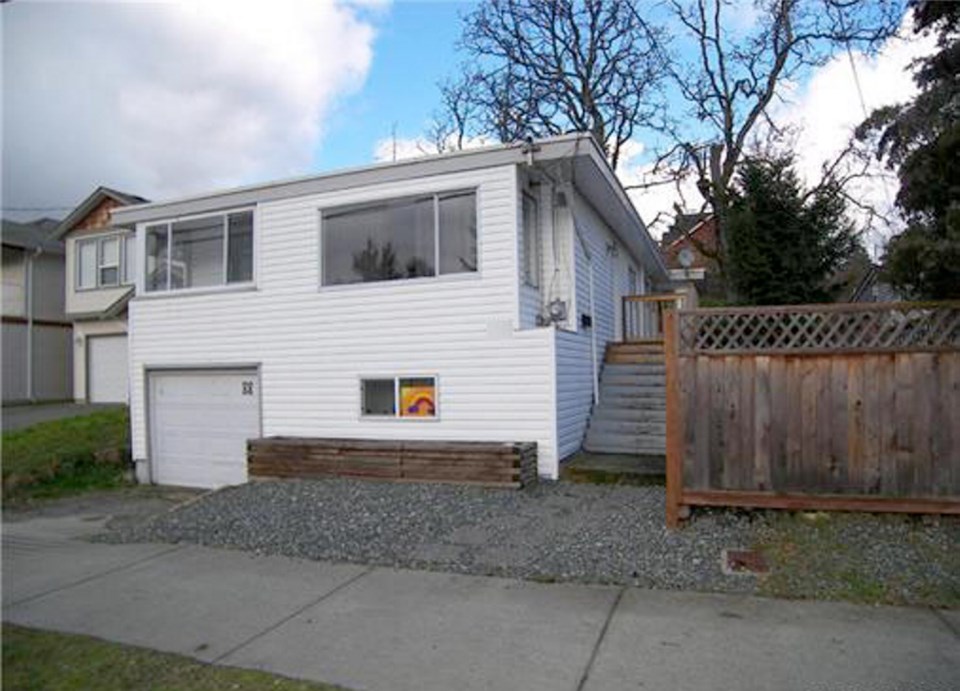 It’s an off-white, flat-roofed, 1,180-square-foot box, crowding the sidewalk on Atkins Avenue in Langford.
It’s an off-white, flat-roofed, 1,180-square-foot box, crowding the sidewalk on Atkins Avenue in Langford.
Built near the railway tracks in 1930, it sits on a sloped lot that an optimist might describe as “maintenance-free,” a euphemism for “rockier than a Kardashian marriage.”
It’s also, at $339,800, the cheapest detached single-family house listed for sale in Greater Victoria. Imagine that.
Better yet, phone your relatives in Winnipeg and tell them. Better still, use FaceTime or Skype so that you can see their expressions as it sinks in that the least-expensive house in Victoria costs 40 grand more than the average one in the Manitoba capital.
Then you tell them: “Frankly, I’m surprised the Langford house is priced that low.”
Which is true, at least according to the Knox Scale, a decidedly unscientific measurement that involves randomly ducking into the market every few years to look for the cheapest detached home in town — town being defined as anything east of Sooke.
The first time I did so, in 2003, the title went to a 750-square-foot, one-bedroom, one-bath home on Fernwood Road. It was a Johnny Bower house: Nobody was sure how old it was. The exterior was painted a shade of purple that fell somewhere between Barney the Dinosaur and Thrills gum. It was listed at $155,000.
That was less than half the price of the cheapest house on the day I went looking in 2007, a tidy 836-square-foot, Esquimalt rancher just off the railway tracks on Colville Road. It was on for $325,000.
In 2011, the lowest-priced place was another little house backing onto the railway tracks (for a town without trains, we have a lot of tracks) in Esquimalt, this time on Lockley Road. It was advertised at $330,000.
Given the soaring values since then, $339,800 for the three-bedroom Atkins Avenue house — complete with updated interior — doesn’t seem bad. It’s attractively priced for someone who wants to get into the market relatively cheaply without paying strata fees, says the listing agent, Darren Day.
And, being a Victorian, you nod your head and agree with the logic, because that’s what affordability looks like in a city where house prices have been outpacing income for decades.
The price-income gap grew to the point that by 2014, the average Greater Victoria single-family house sold for $609,342, seven times the median household income of $86,430. In 2015, the average price hit $649,550 — and that was before the market took off this year. Thank heaven for low interest rates.
These are the kind of numbers we like to throw at relatives from Back East (defined as anywhere beyond Hope) as we gather around the campfire at family reunions. Victorians enjoy telling jaw-dropping house-price stories the way other Canadians brag about harsh weather.
Where they crow of hail the size of golf balls (“Hec Wilson got brained so hard he can’t count past four no more”), we boast of multiple-offer frenzies (“Rats the size of cocker spaniels and it went for 250 over asking”).
And where other Canadians dread ice storms, blizzards and wildfires, Victorians are most afraid of A) a subduction-zone earthquake, B) Armageddon, or C) prime jumping two points.
This is what happens when people plow so much of their money into their homes. The 70 per cent of Victorians who are homeowners (as opposed to the 30 per cent woefully watching prices rise) think of their houses as retirement nest eggs, or as their insurance against poverty, their wood-frame parachute: If need be, you can sell up, buy the nicest house in Violated Livestock, Sask., and live like royalty until the night you make the fatal mistake of trying to wobble home from the Legion while clad in Victoria winter wear (fleece vest, yoga pants, Birkenstocks). It turns out there’s a reason why house prices are so high in the City of Gardens: nobody ends up frozen in a snowbank like Jack Nicholson in The Shining.
In fact, a study published in the Canadian Journal of Economics in 2012 found Victorians enjoy the best quality of life in the country, based on a formula involving wages and house prices that showed us willing to make sacrifices worth 17 per cent of our income to live here.
Frustrated by high prices? We can always leave. You go first.



